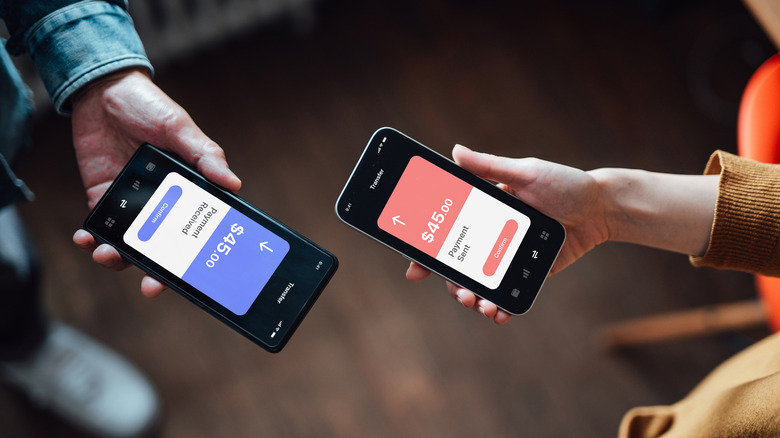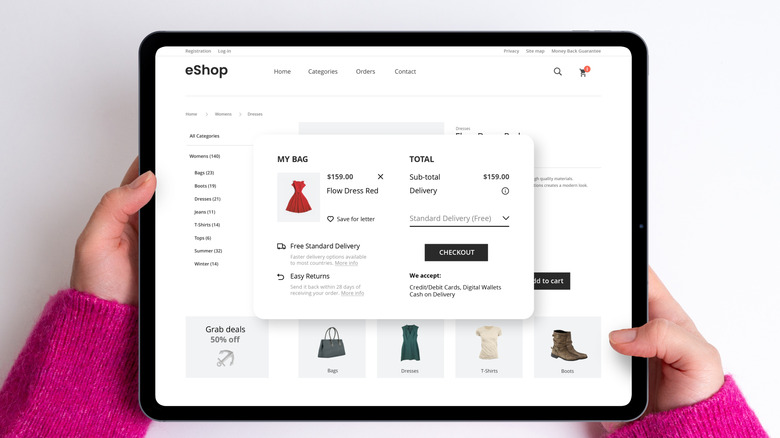5 Warning Signs An Online Seller Is Scamming You
If you're like many online shoppers, you've had the experience of spotting the exact item you've been wanting — at a much lower price than anywhere else — while scrolling through your favorite shopping site. Before clicking "buy," you do your due diligence: fast shipping, check; photos look legit, check. You conclude it's a deal that's too good to pass up. Unfortunately, that's exactly how online scams often begin.
Whether you've stumbled upon the shady side of Alibaba, messaged a seller on Facebook Marketplace, or landed on a fake website designed to look like the real thing, getting caught up in the excitement of a good deal can lead you to fall for an online scam. According to the Federal Trade Commission (FTC), online shopping ranks as the second most reported fraud category, with only imposter scams being reported more often. Online scams can happen on large marketplaces like eBay or Amazon, as well as through misleading ads on social media platforms that direct you to fraudulent sellers. They can be so convincing that they can even fool the most careful shoppers. However, knowing the warning signs can help keep you safe as you shop for your next deal online.
They insist on unusual payment methods
A telltale sign of an online shopping scam is the seller pushing you to use a risky or irreversible payment method — wire transfers, gift cards, cryptocurrency, and peer-to-peer (P2P) apps — instead of a credit card to buy refurbished tech or PayPal to buy concert tickets or something else. They push these less-than-secure payment methods for a reason: they know you usually can't reverse them once you send the money. For example, if a seller ever asks you to buy a gift card and send them the code, they're trying to scam you. A gift card isn't a form of payment; it's the equivalent of handing cash to the seller, something a legitimate business will never ask you to do.
Wire transfers are another scammer favorite because once the money is sent, it's fast, final, and hard to recover. The FTC warns shoppers to "never wire money to anyone you haven't met in person — no matter the reason they give." If an online seller is pressuring you to wire them money, there's a very high chance they're attempting to scam you. As crypto has gained popularity, more and more scam artists have begun using it as a way to collect payments that are impossible to reverse. If a seller insists that you pay in crypto, it's a red flag and almost always a scam. The same goes for mobile P2P apps like Venmo, Cash App, or Zelle, which offer little to no buyer protection, meaning once you've sent the money, there's usually no way to get it back.
The price seems too good to be true
Few among us don't enjoy the satisfaction of scoring a good deal online. Whether we're saving money when shopping on Amazon or snagging a discount from a lesser-known retailer, it's hard not to feel like you've won when you find a bargain — unless it turns out to be a scam. If you come across an item online and the price seems just too good to be true, it probably is. Offering items at prices that are much lower than anywhere else is one of the most common bait tactics scammers use. This is especially true for popular, brand-name products where demand is high. Scam artists understand psychology and that many shoppers will let their guard down when they see what looks like a rare deal. They're hoping your excitement will override your usual caution, making you click "buy" before really thinking about it.
Social media is another breeding ground for online shopping scams, with ads promising steep discounts on brand-name products. Click on the wrong ad, and you might end up on a scam site where you're sent fakes or nothing at all. It's the classic "bait-and-switch," where a company lures you in with a low price and leaves you empty-handed or stuck with a cheap imitation. Before you click "buy," take some time to compare prices by searching for the product at reputable retailers, reading online reviews, and factoring in shipping time and return policies. If the deal you saw on social media is significantly cheaper, especially if you can't find any reviews and the seller doesn't offer purchase protections, don't buy the product.
The site or listing looks unprofessional or rushed
Sellers who are looking to scam you out of your money will often rush through setting up a website or posting a listing, and if you're paying attention, you'll be able to spot the red flags that will help you determine if you're on a scam website before pressing 'add to cart' and handing your money over to a scammer. One clue that you're dealing with a scam website is terrible grammar and awkward phrasing. If you notice things like misspellings, clunky syntax, or sentences that just don't flow naturally, you may be shopping on a fake website. However, thanks to generative AI, many scam websites feature error-free, legitimate-sounding copy and product descriptions. So instead of just looking for poor grammar, watch for signs the site was thrown together quickly: inconsistent branding, poor image quality, vague or missing contact info, and reused boilerplate copy.
Another scammer tactic is making slight tweaks to the name of a well-known brand, hoping you won't catch on. If you see a URL like "amaz0n.com" or "brandshop‑official.net," there's a good chance it's a front for fraud. The web page you're considering purchasing an item from should have an About Us section with their shipping policies, a valid address, and verifiable contact information. If you notice the site doesn't have this information or is very generic, you might be dealing with a scam. Scam sites often come online just days before promoting their "deals" and disappear soon after. That's why you should always check the domain creation date with a tool like WHOIS. If the site was registered just a few days before listing major brand-name deals, consider that a warning sign.
The seller tries to move the transaction off the platform
If you're purchasing an item through a marketplace like eBay, Facebook Marketplace, or TikTok Shop, you should always complete the transaction on the platform itself. When a seller pressures you to continue the deal through private messages, texts, or email, instead of processing the payment through the official marketplace, that should set off alarm bells. That's because many platforms have put protections in place to protect buyers, including refund policies and dispute resolution. However, once you move the transaction off the platform, these protections usually no longer apply. That means you'll have little recourse if the item never arrives or turns out to be a scam.
For example, you should be wary if a seller asks you to pay using PayPal's Friends & Family option rather than the Goods and Services method. Friends & Family is designed to be used only with your trusted contacts and doesn't come with purchase protections, making it difficult (or impossible) to get your money back if something goes wrong. Similarly, the eBay Money Back Guarantee explicitly excludes purchases paid for off the platform. Facebook's Purchase Protection also applies only to transactions made through Facebook Checkout. If a seller pressures you to pay for your purchase off the platform you're using or to use an unprotected payment option like Venmo, Zelle, crypto, or Friends & Family, that's a clear sign to walk away.
No independent reviews or negative feedback
If you're interacting with a legitimate seller, they should have an online footprint. Whether they're on a big platform or a small website, they should have a history you can check, including customer reviews on sites like Google, Trustpilot, the Better Business Bureau (BBB), and social media. If you can't find any reviews or just a handful of vague, perfect-sounding comments for a seller you're thinking about purchasing a product from, think twice before buying, because that's often a sign of a scam.
With practice, you can become proficient at spotting fake customer reviews, which are often glowing and don't say much, like "Great Seller!" Platforms like Amazon and Etsy have put in a lot of work to combat these fake listings, but they're still out there. If you see a review from a generic profile like "John Smith" with no photo or purchase history, you may be looking at a fake review. If all of the reviews were published around the same time and gave the seller a five-star rating, that's another sign that you could be dealing with a scammer. A lack of negative reviews for a seller is also suspicious because in the real world, nobody has a perfect track record. Even top-rated, legitimate sellers will get some complaints about delays, product defects, or misunderstandings.





